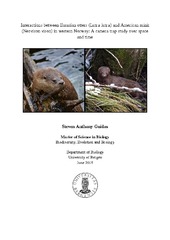| dc.description.abstract | Classic ecological theory suggests that a large amount of niche overlap between two competing species will lead to the decline or exclusion of the less dominant species. However, despite competition being a major evolutionary force within assemblages of closely related organisms, it is difficult to test for in the field. The recent return of the Eurasian otter (Lutra lutra) to partsof its historic range in Norway presentedarare opportunity to examine the effects of competition on an invasive competitor, the American mink (Neovison vison), which has managed to colonizemuch of the country afterthe otterwas exterminated from many parts of its historic rangeby extensive hunting. Theoretical and anecdotal evidence suggests that over time, otter should outcompete mink in areas it has reestablished. However,most of this evidence is based on studies conducted in limnicecosystems, and little is known of this relationship in the coastal marine environment.This study is the first to examine the competitive relationship of otter and mink over time in a coastal ecosystem using wildlife cameras.Cameras were placed at nested locations inthe coastal fjord regions of Norway to examine how local otter and mink populations fluctuate over a three-year timeframe in an area recentlyreestablished by otter. This was compared to another location where otter and mink have cohabited for roughly thirty years. I found that over the course of the experiment, the number of mink sightings on camerain the area recently reestablished by ottersignificantly decreased, while that of the otter increased. Mink populations have disappeared in areas where otters have been present for long periods of time, at least in the context of small, local scales. Mink were significantly less active in periods of increased otter activity, which supports existing evidence that the relationship between the two species relies oninterspecific aggression. Mink also decreased their amount of activity around midnight, which coincided with the timeframe in which otter were most active. This study lends support to the anecdotal evidence that suggestsotter are dominant competitors to mink in areas they cohabit, although the potential for otter to permanently eradicate mink from large areas is uncertain. The displacement of mink by otter will likely have impacts on species that are heavily preyed upon by mink and their competitors. Moreinformation is needed as to what extent otter displace mink from various types of ecosystems, and what effects this will have on local seabird, rodent and native mustelid species throughout Norway. | en_US |
